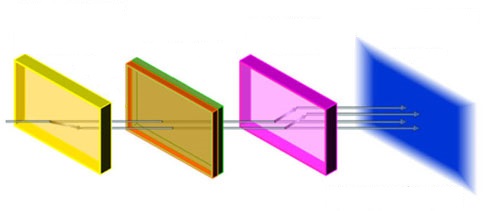An Optical Low Pass Filter (OLPF), is sometimes referred to as an Anti-Aliasing filter. The filter is built into many digital cameras and is located directly in front of the image sensor. The main role of the OLPF is to stop high-frequency image information and reduce the effects of moiré and false colour caused by high-frequency waves in images. Moiré occurs in scenes containing repetitive details, such as patterns in textiles and clothing or in the strong vertical lines of architecture. These patterns do not appear in nature which is why moiré and false colour very rarely occur with landscape and nature photography.
The OLPF generally consists of two layers of birefringent plates and one wavelength plate. Light is split while being transmitted through the birefringent plates onto the image sensor as shown below. In addition, IR coating, AR coating, and IR absorption glass are also used for better colour reproduction characteristics.

Digital cameras that do not have an OLPF allow high-frequency image information to be recorded, this increases image sharpness. This also means that moiré and false colour may be slightly noticeable according to the subject and shooting conditions. However, digital cameras are incorporating increasingly higher resolution sensors. As higher resolution sensors contain a greater number of pixels with a smaller pixel pitch, the occurrence of moiré and false colour in images is reduced. This reduction in risk increases the possibility to remove the OLPF with high-resolution cameras to take advantage of the increased image sharpness.
Digital cameras are designed to produce the best colour reproduction performance possible from the image sensor. Image sharpness and the need for a level of suppression of moiré and false colour both have to be considered during camera design.